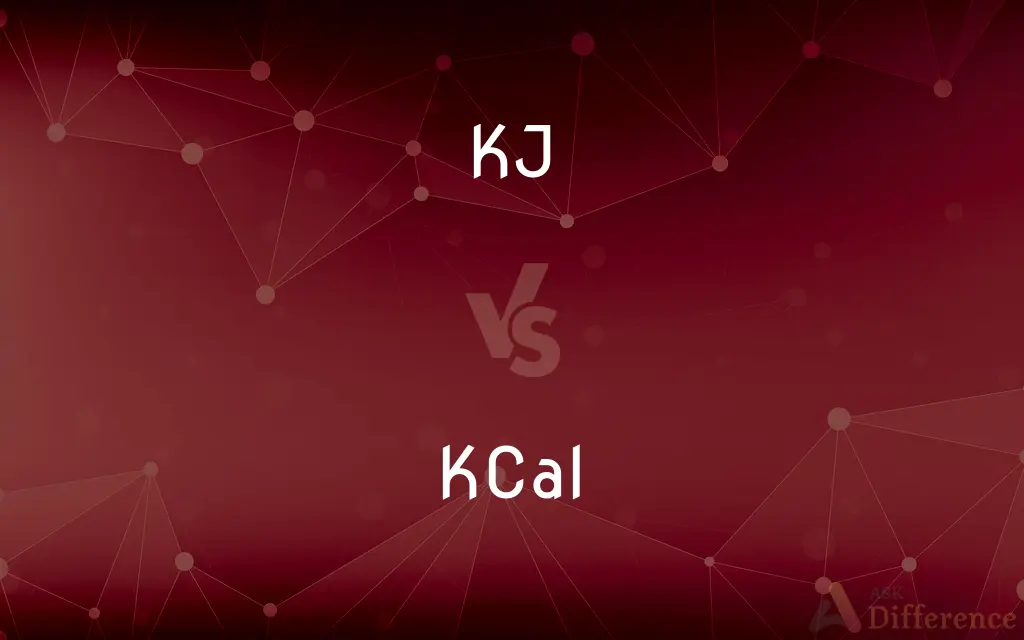KJ vs. KCal — What's the Difference?
By Tayyaba Rehman — Published on November 5, 2023
KJ (kilojoule) is a unit of energy equal to 1,000 joules, while KCal (kilocalorie) is a unit of energy equal to 1,000 calories, often used in nutritional contexts.

Difference Between KJ and KCal
Table of Contents
ADVERTISEMENT
Key Differences
KJ and KCal are both units of energy, but they represent different magnitudes and are used in varying contexts. KJ, which stands for kilojoule, is part of the metric system and is widely accepted in scientific calculations. On the other hand, KCal, short for kilocalorie, is commonly utilized in nutritional contexts, especially in the United States.
When one encounters the term "calorie" on a food label, it's actually referring to a KCal, or what's scientifically known as a "large calorie." Conversely, the KJ is more often found in fields like physics and chemistry. However, some countries now include both KJ and KCal values on food labels to provide a comprehensive understanding.
In terms of conversion, 1 KCal is approximately equivalent to 4.184 KJ. This means when converting from calories to joules or vice versa, this factor is used. So, if a candy bar contains 200 KCal, it would also contain roughly 836.8 KJ of energy.
Another distinction is regional preference. While many countries use KCal to express food energy, countries like Australia, New Zealand, and some in Europe have adopted the KJ as the standard on nutritional labels. Regardless of the unit, the purpose remains the same: to quantify the amount of energy.
Lastly, the importance of understanding both KJ and KCal becomes evident when considering dietary needs or scientific calculations. Though different in magnitude, both units provide a measure of energy, ensuring consistent and accurate representations in their respective contexts.
ADVERTISEMENT
Comparison Chart
Full Form
Kilojoule
Kilocalorie
Common Usage
Physics, chemistry
Nutrition, food labels
Equivalence
1 KCal ≈ 4.184 KJ
1 KCal = 1,000 calories
System
Metric
Commonly used in U.S. nutritional contexts
Purpose
Measure energy in scientific contexts
Measure energy in foods
Compare with Definitions
KJ
Used in fields like physics and chemistry.
The chemical bond has an energy of 10 KJ.
KCal
Different from the small "calorie" used in science.
When people say they're counting calories, they're usually referring to KCals.
KJ
An alternative to KCal in food energy representation.
European food labels often display energy in KJ.
KCal
Common on American food labels.
The soda can lists its energy content as 250 KCal.
KJ
Common in scientific energy calculations.
The experiment showed a heat absorption of 120 KJ.
KCal
Represents 1,000 calories, commonly used in nutrition.
The cookie contains 150 KCal.
KJ
1/1000th of a joule.
The device requires 2,000 KJ to operate.
KCal
Measures the energy in foods and drinks.
If you're looking to gain weight, you might aim for a higher KCal intake.
KJ
A metric unit for measuring energy.
The reaction released 50 KJ of energy.
KCal
A large calorie used to quantify food energy.
Diet recommendations often suggest daily intakes, like 2,000 KCal for adults.
KCal
Abbreviation of kilocalorie
Common Curiosities
How is KCal defined in terms of calories?
KCal, often referred to as a "large calorie" in nutrition, is equivalent to 1,000 small calories.
Which unit is more commonly used in food labeling in the U.S.?
In the U.S., food energy is typically represented in KCal on nutrition labels.
How can I convert values from KCal to KJ?
To convert from KCal to KJ, multiply the KCal value by 4.184.
Is KJ the standard unit for energy globally?
While KJ is widely accepted in many countries, especially for scientific purposes, its usage in food labeling varies by region, with some countries preferring KCal.
If a food item has 100 KCal, how many KJ does it have?
A food item with 100 KCal would have approximately 418.4 KJ.
Why might someone need to know the difference between KJ and KCal?
Understanding both KJ and KCal is essential for interpreting food labels, especially when traveling or importing products from different countries.
What does KJ represent in measurements?
KJ stands for kilojoule, a unit of energy commonly used in the metric system.
Why do some countries prefer KCal over KJ for food labeling?
Historical practices, consumer familiarity, and regulatory standards influence the preference for KCal over KJ in some countries.
Can exercise machines display energy expenditure in both KJ and KCal?
Yes, many modern exercise machines offer settings to display energy burned in either KJ or KCal, catering to user preferences.
Which unit, KJ or KCal, provides a larger magnitude of energy?
1 KCal provides a larger amount of energy than 1 KJ, specifically about 4.184 times larger.
Can I find both KJ and KCal on food labels?
Yes, some countries list both KJ and KCal on food labels to cater to international standards and preferences.
In which fields or industries might I encounter the unit KJ more frequently?
KJ is commonly used in scientific fields like physics and chemistry for energy-related measurements.
How do KJ and KCal relate to daily energy requirements?
Both KJ and KCal can represent daily energy intake or expenditure. For instance, a common guideline might suggest a daily intake of 2,000 KCal or 8,368 KJ for adults.
If I'm tracking my diet, how can I switch between KJ and KCal effectively?
Utilize the conversion factor (1 KCal = 4.184 KJ) or use dietary apps that allow for easy switching between units.
Are KJ and KCal interchangeable in recipes or dietary plans?
While they both measure energy, they're not directly interchangeable due to their different magnitudes. One should convert values appropriately when using them in recipes or dietary plans.
Share Your Discovery

Previous Comparison
Coffee Beans vs. Cocoa Beans
Next Comparison
Mountain Time vs. Eastern TimeAuthor Spotlight
Written by
Tayyaba RehmanTayyaba Rehman is a distinguished writer, currently serving as a primary contributor to askdifference.com. As a researcher in semantics and etymology, Tayyaba's passion for the complexity of languages and their distinctions has found a perfect home on the platform. Tayyaba delves into the intricacies of language, distinguishing between commonly confused words and phrases, thereby providing clarity for readers worldwide.













































